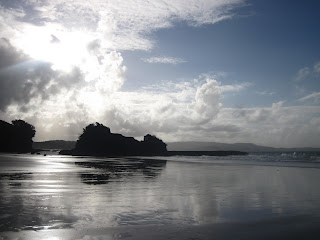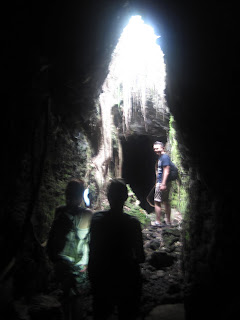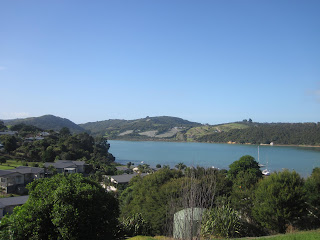After a surprisingly good (if hot and stifling) night's sleep, we set off for Rotorua on Saturday morning.
We had initially been encouraged by the car rental man telling us we couldn't get lost because there aren't many roads. This was partly true - the bit about the not many roads anyways. The problem with not many roads is there aren't many road signs; you can be driving down a state highway for an hour before discovering you're going in the wrong direction.
This happened to us.
And it was windy mountain state highway too, so I was about to throw up on everyone.
After a brief travel sickness-induced stop in somewhere small and unremarkable, we got to Rotorua just after lunchtime.
Rotorua is a city on the banks of a lake of the same name. Rotorua comes from the full Maori name 'Te Rotorua-nui-a-Kahumatamomoe', which translates as 'the second lake of Kahumatamomoe' (roto meaning lake, rua meaning two). It was the second lake discovered by the chief of the Te Awara tribe (mentioned in my previous post - they get around), and he dedicated it to his uncle, Kahumatamomoe. Presumably he was a pretty nice guy.
Rotorua's other, informal name, is Sulphur City. This is because the whole place stinks of sulphur, due to the geothermal activity in the area. There are numerous hot springs, geysers, and bubbling mud pools in the area, so we decided to go see some.
Unfortunately the best geothermal sights are a little way out of the city, so we had to make do with visiting Kuirua Park in the centre as we were pushing for time. This park has bubbling mud pools and steaming hot springs dotted around, and so when the wind is blowing towards you you can get a pretty noxious gas cloud in your face. There are also hot spas for dipping yourselves around the park too.
Here is a bubbling mud pool:
After this we went for a late lunch (Japanese - nom) and then me and DrC headed back to our slightly bigger six person bedroom for a nap, as we were KOed from the travel sickness tablets.
In the evening we went to a Maori village for a cultural evening. We were picked up from our hostel by a driver and taken to the office. We were instructed in how the evening was going to pan out. We were to be members of the 'Huia' waka (canoe). Our waka looked suspiciously like a coach, and handled pretty well on roads. Our driver was named Wati, and he was pretty insane. On route to the village he chose our ariki (chief), who was called Darren, from Australia. We did some grunting to show we were rowing our coach waka, and then arrived at the village.
Before we could enter the marae (sacred place) the Powhiri, the formal welcoming ceremony, had to be performed. A series of intimidating haka (dances) were performed by members of the tribe, and then the chiefs had to accept the teka (peace offering) to signify their peaceful intent. There was then some more singing and dancing, and we were allowed into the village as 'tangata whenau' ('one of our people').
I am glad only men could be the chiefs, as the haka were pretty scary.
In the village, we walked around different huts and learned about different parts of everyday Maori life. For example, before Westerners arrived in Aotearoa they had no written language, so they told stories and recorded information by carvings on doorframes and decorations. They also had no metals, so they did this all using bone chisels.
It was actually their lack of metals that made the Maori people welcome the British with open arms originally, as we gave them muskets so they could fight their rival tribes.
They also didn't have alcohol or drugs. We helpfully gave them those too.
After learning about such things, we went to observe the lifting of the hangi meal. The hangi is a pit in the ground, in which white hot stones are placed. Baskets of food are then placed on the stones, sacking (they used to use leaves and bark) is placed over these, and dirt is piled on top to seal it off. It is then left for several hours. Here is one hangi being opened:
The wellies are not traditional Maori dress.
While the rest of the hangi was being prepared, we went to the Wharenui, which is a sacred meeting house, to experience some Maori song and dance. This was very lively and energetic, and each song seemed to hold some significance in Maori culture. They performed the haka used by the All Blacks at the end, and it was very powerful. There was also one very attractive warrior wearing just a loin cloth and traditional tattoos, which was nice.
After this, it was time for our hangi meal. This means I am going to have to discuss the food in this post, and not in a 'New Zealand Foodstuffs Part ?' post. My inner autistic child is quite disturbed by the break in continuity.
The method of cooking the hangi gave everything a very distinct smoky taste. It was not unpleasant, and I easily put away two plates of grub, but I don't think I'd have another one. They also provided gravy and cranberry sauce with the meat, which I'm not sure is very traditional.
After the hangi it was home time, and Wati drove our coach waka back to our hostel. It was this drive that showed us he was insane - he drove round and round and round and round a roundabout singing the whole of 'She'll be coming round the mountain'.
Overall, the evening was very fun and enjoyable. I did feel a bit uneasy for a lot of it though, as I was very conscious of the fact that it was a 'cultural insight' aimed at Western tourists, and I felt a bit like I was offending the Maori people by reducing their culture to a tourist attraction just by being there. This was probably misplaced guilt over the fact that the British oppressed the Maori and took away their ancestral land, as the workers at the village seemed proud to be sharing parts of their culture with us, and wanted us to learn and appreciate their way of life.
After that, is was another interesting sleep in a six bed room, but this time it smelled of rotten eggs.









































